BS3979 - Change Management Portfolio: System Theory Application
VerifiedAdded on 2023/06/15
|18
|4597
|136
Portfolio
AI Summary
This portfolio delves into the intricacies of change management within organizations, beginning with a critical evaluation of system theory and its real-world applications, including practical interventions for managers. It then presents a detailed change plan for Fizz Event Management, focusing on team building, leadership development, and addressing potential weaknesses. The portfolio further explores the crucial role of middle managers in facilitating change, acknowledging their emotional responses. Finally, it reflects on how the module has influenced the author's personal attitudes and responses to change, highlighting the importance of understanding and managing change effectively within dynamic organizational environments. Desklib offers a range of resources, including past papers and solved assignments, to support students in their study of change management and related topics.
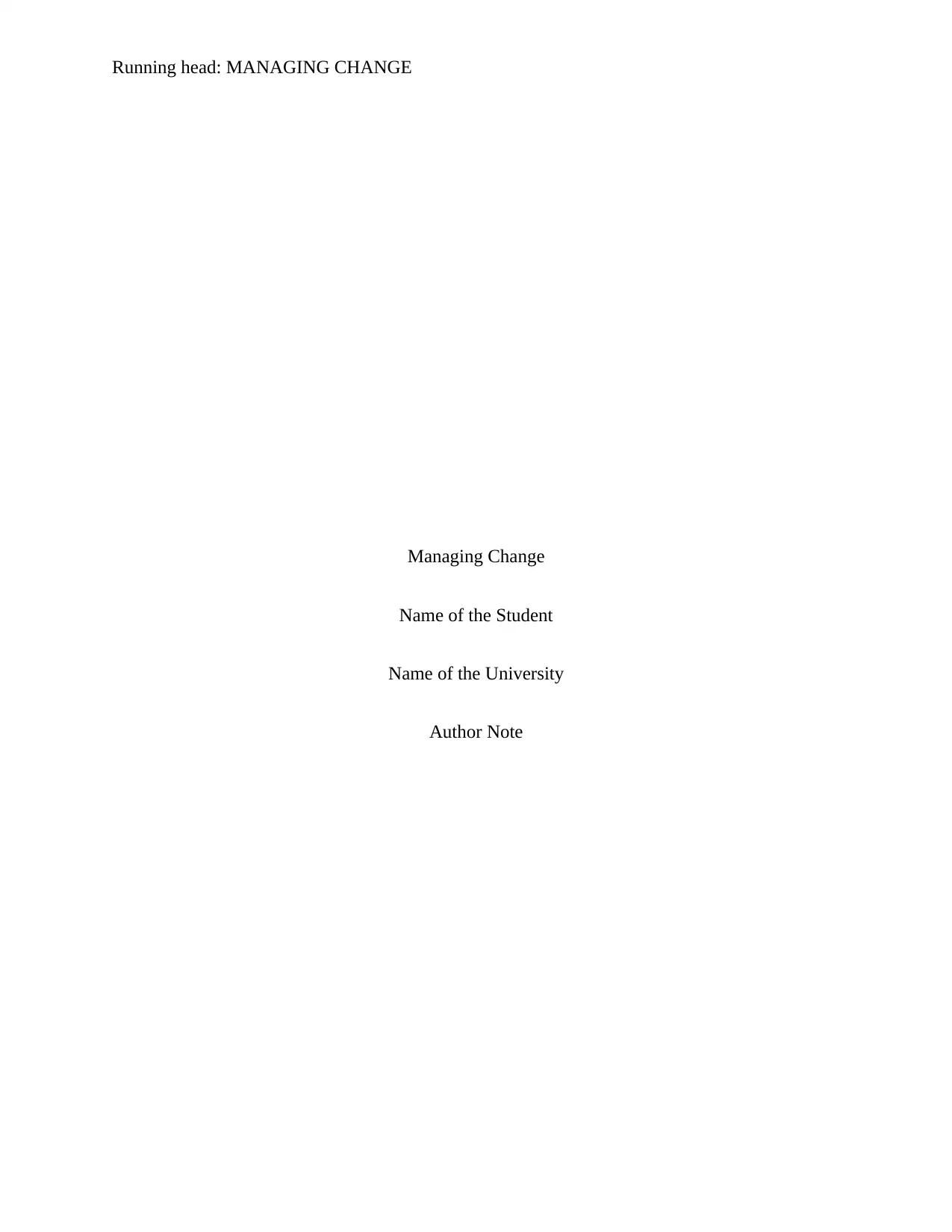
Running head: MANAGING CHANGE
Managing Change
Name of the Student
Name of the University
Author Note
Managing Change
Name of the Student
Name of the University
Author Note
Paraphrase This Document
Need a fresh take? Get an instant paraphrase of this document with our AI Paraphraser
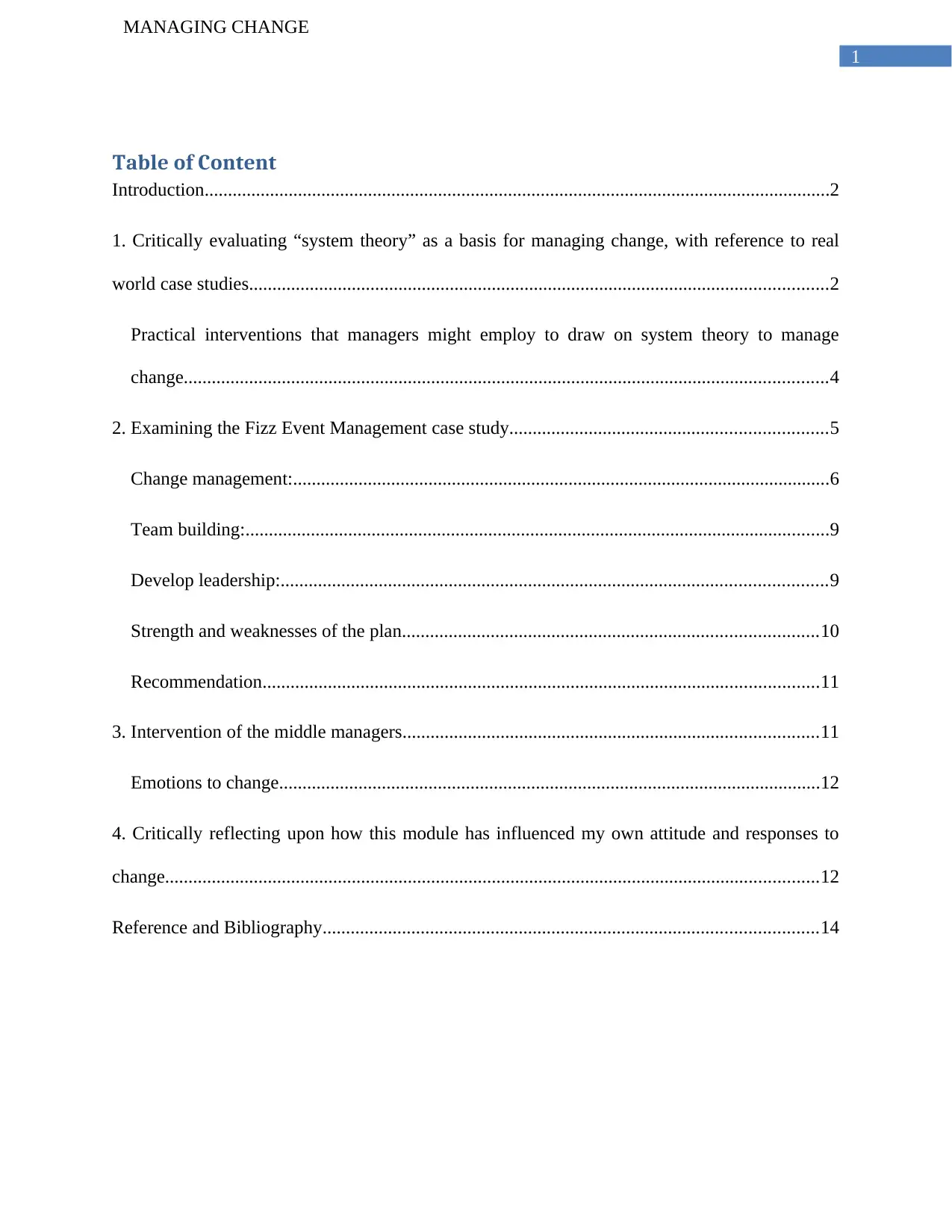
1
MANAGING CHANGE
Table of Content
Introduction......................................................................................................................................2
1. Critically evaluating “system theory” as a basis for managing change, with reference to real
world case studies............................................................................................................................2
Practical interventions that managers might employ to draw on system theory to manage
change..........................................................................................................................................4
2. Examining the Fizz Event Management case study....................................................................5
Change management:...................................................................................................................6
Team building:.............................................................................................................................9
Develop leadership:.....................................................................................................................9
Strength and weaknesses of the plan.........................................................................................10
Recommendation.......................................................................................................................11
3. Intervention of the middle managers.........................................................................................11
Emotions to change....................................................................................................................12
4. Critically reflecting upon how this module has influenced my own attitude and responses to
change............................................................................................................................................12
Reference and Bibliography..........................................................................................................14
MANAGING CHANGE
Table of Content
Introduction......................................................................................................................................2
1. Critically evaluating “system theory” as a basis for managing change, with reference to real
world case studies............................................................................................................................2
Practical interventions that managers might employ to draw on system theory to manage
change..........................................................................................................................................4
2. Examining the Fizz Event Management case study....................................................................5
Change management:...................................................................................................................6
Team building:.............................................................................................................................9
Develop leadership:.....................................................................................................................9
Strength and weaknesses of the plan.........................................................................................10
Recommendation.......................................................................................................................11
3. Intervention of the middle managers.........................................................................................11
Emotions to change....................................................................................................................12
4. Critically reflecting upon how this module has influenced my own attitude and responses to
change............................................................................................................................................12
Reference and Bibliography..........................................................................................................14
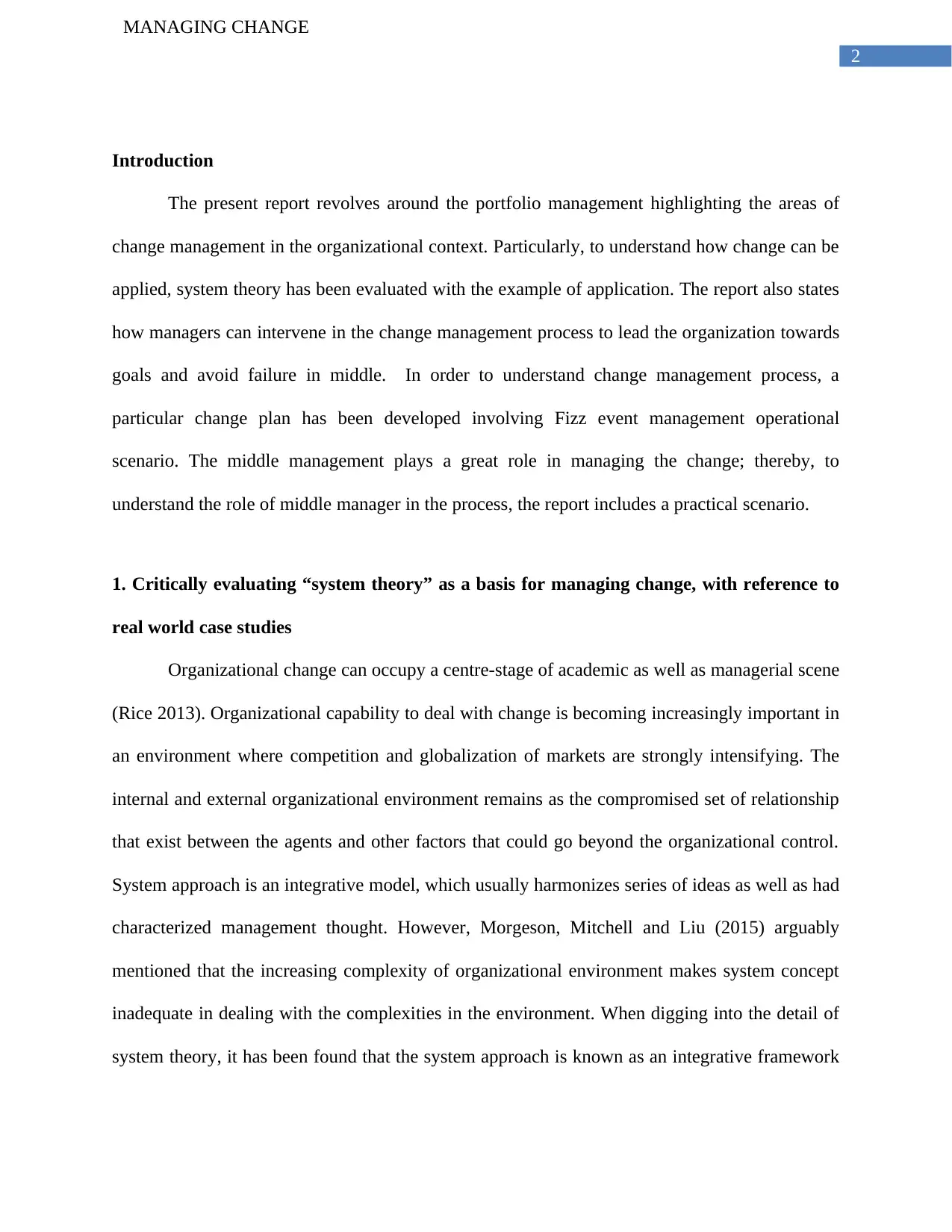
2
MANAGING CHANGE
Introduction
The present report revolves around the portfolio management highlighting the areas of
change management in the organizational context. Particularly, to understand how change can be
applied, system theory has been evaluated with the example of application. The report also states
how managers can intervene in the change management process to lead the organization towards
goals and avoid failure in middle. In order to understand change management process, a
particular change plan has been developed involving Fizz event management operational
scenario. The middle management plays a great role in managing the change; thereby, to
understand the role of middle manager in the process, the report includes a practical scenario.
1. Critically evaluating “system theory” as a basis for managing change, with reference to
real world case studies
Organizational change can occupy a centre-stage of academic as well as managerial scene
(Rice 2013). Organizational capability to deal with change is becoming increasingly important in
an environment where competition and globalization of markets are strongly intensifying. The
internal and external organizational environment remains as the compromised set of relationship
that exist between the agents and other factors that could go beyond the organizational control.
System approach is an integrative model, which usually harmonizes series of ideas as well as had
characterized management thought. However, Morgeson, Mitchell and Liu (2015) arguably
mentioned that the increasing complexity of organizational environment makes system concept
inadequate in dealing with the complexities in the environment. When digging into the detail of
system theory, it has been found that the system approach is known as an integrative framework
MANAGING CHANGE
Introduction
The present report revolves around the portfolio management highlighting the areas of
change management in the organizational context. Particularly, to understand how change can be
applied, system theory has been evaluated with the example of application. The report also states
how managers can intervene in the change management process to lead the organization towards
goals and avoid failure in middle. In order to understand change management process, a
particular change plan has been developed involving Fizz event management operational
scenario. The middle management plays a great role in managing the change; thereby, to
understand the role of middle manager in the process, the report includes a practical scenario.
1. Critically evaluating “system theory” as a basis for managing change, with reference to
real world case studies
Organizational change can occupy a centre-stage of academic as well as managerial scene
(Rice 2013). Organizational capability to deal with change is becoming increasingly important in
an environment where competition and globalization of markets are strongly intensifying. The
internal and external organizational environment remains as the compromised set of relationship
that exist between the agents and other factors that could go beyond the organizational control.
System approach is an integrative model, which usually harmonizes series of ideas as well as had
characterized management thought. However, Morgeson, Mitchell and Liu (2015) arguably
mentioned that the increasing complexity of organizational environment makes system concept
inadequate in dealing with the complexities in the environment. When digging into the detail of
system theory, it has been found that the system approach is known as an integrative framework
⊘ This is a preview!⊘
Do you want full access?
Subscribe today to unlock all pages.

Trusted by 1+ million students worldwide
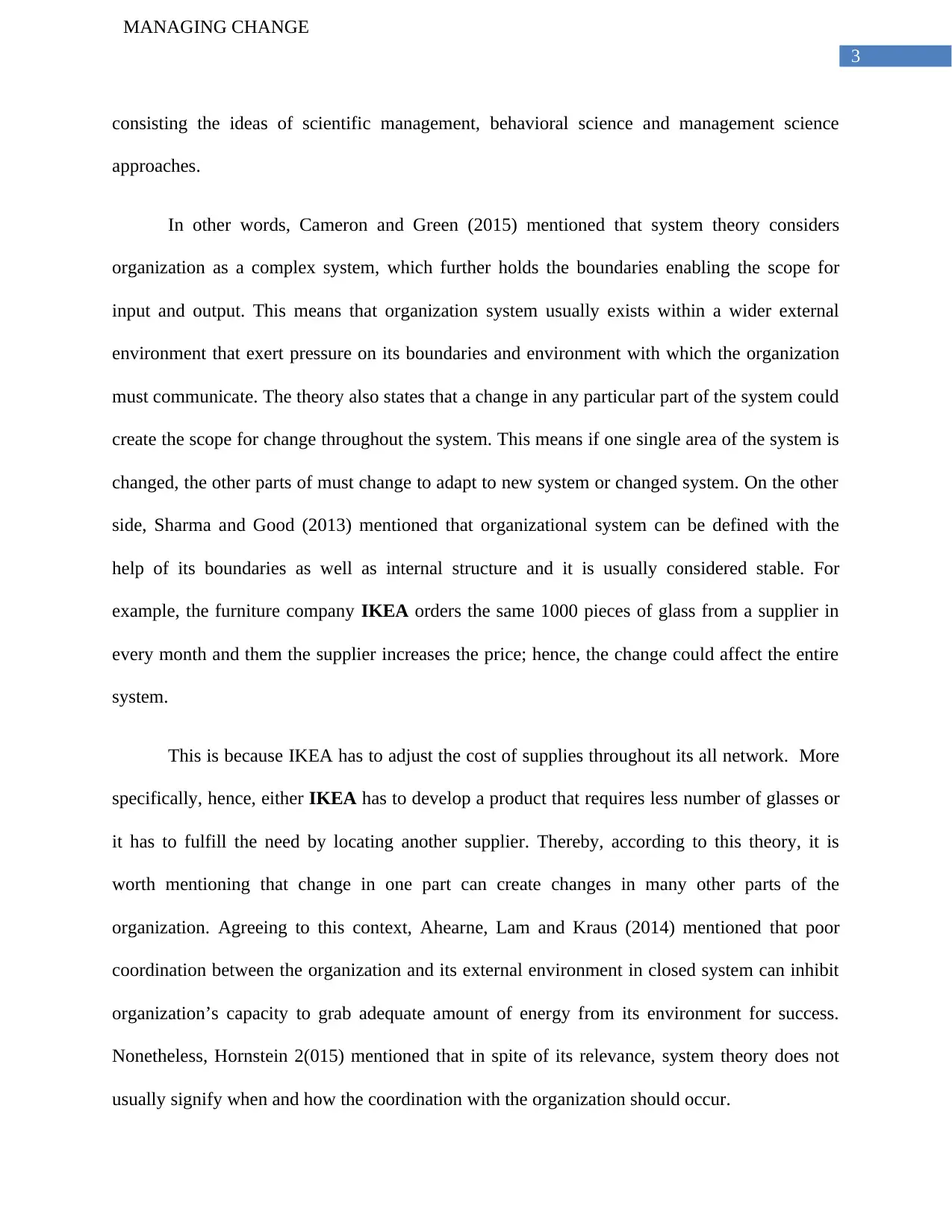
3
MANAGING CHANGE
consisting the ideas of scientific management, behavioral science and management science
approaches.
In other words, Cameron and Green (2015) mentioned that system theory considers
organization as a complex system, which further holds the boundaries enabling the scope for
input and output. This means that organization system usually exists within a wider external
environment that exert pressure on its boundaries and environment with which the organization
must communicate. The theory also states that a change in any particular part of the system could
create the scope for change throughout the system. This means if one single area of the system is
changed, the other parts of must change to adapt to new system or changed system. On the other
side, Sharma and Good (2013) mentioned that organizational system can be defined with the
help of its boundaries as well as internal structure and it is usually considered stable. For
example, the furniture company IKEA orders the same 1000 pieces of glass from a supplier in
every month and them the supplier increases the price; hence, the change could affect the entire
system.
This is because IKEA has to adjust the cost of supplies throughout its all network. More
specifically, hence, either IKEA has to develop a product that requires less number of glasses or
it has to fulfill the need by locating another supplier. Thereby, according to this theory, it is
worth mentioning that change in one part can create changes in many other parts of the
organization. Agreeing to this context, Ahearne, Lam and Kraus (2014) mentioned that poor
coordination between the organization and its external environment in closed system can inhibit
organization’s capacity to grab adequate amount of energy from its environment for success.
Nonetheless, Hornstein 2(015) mentioned that in spite of its relevance, system theory does not
usually signify when and how the coordination with the organization should occur.
MANAGING CHANGE
consisting the ideas of scientific management, behavioral science and management science
approaches.
In other words, Cameron and Green (2015) mentioned that system theory considers
organization as a complex system, which further holds the boundaries enabling the scope for
input and output. This means that organization system usually exists within a wider external
environment that exert pressure on its boundaries and environment with which the organization
must communicate. The theory also states that a change in any particular part of the system could
create the scope for change throughout the system. This means if one single area of the system is
changed, the other parts of must change to adapt to new system or changed system. On the other
side, Sharma and Good (2013) mentioned that organizational system can be defined with the
help of its boundaries as well as internal structure and it is usually considered stable. For
example, the furniture company IKEA orders the same 1000 pieces of glass from a supplier in
every month and them the supplier increases the price; hence, the change could affect the entire
system.
This is because IKEA has to adjust the cost of supplies throughout its all network. More
specifically, hence, either IKEA has to develop a product that requires less number of glasses or
it has to fulfill the need by locating another supplier. Thereby, according to this theory, it is
worth mentioning that change in one part can create changes in many other parts of the
organization. Agreeing to this context, Ahearne, Lam and Kraus (2014) mentioned that poor
coordination between the organization and its external environment in closed system can inhibit
organization’s capacity to grab adequate amount of energy from its environment for success.
Nonetheless, Hornstein 2(015) mentioned that in spite of its relevance, system theory does not
usually signify when and how the coordination with the organization should occur.
Paraphrase This Document
Need a fresh take? Get an instant paraphrase of this document with our AI Paraphraser
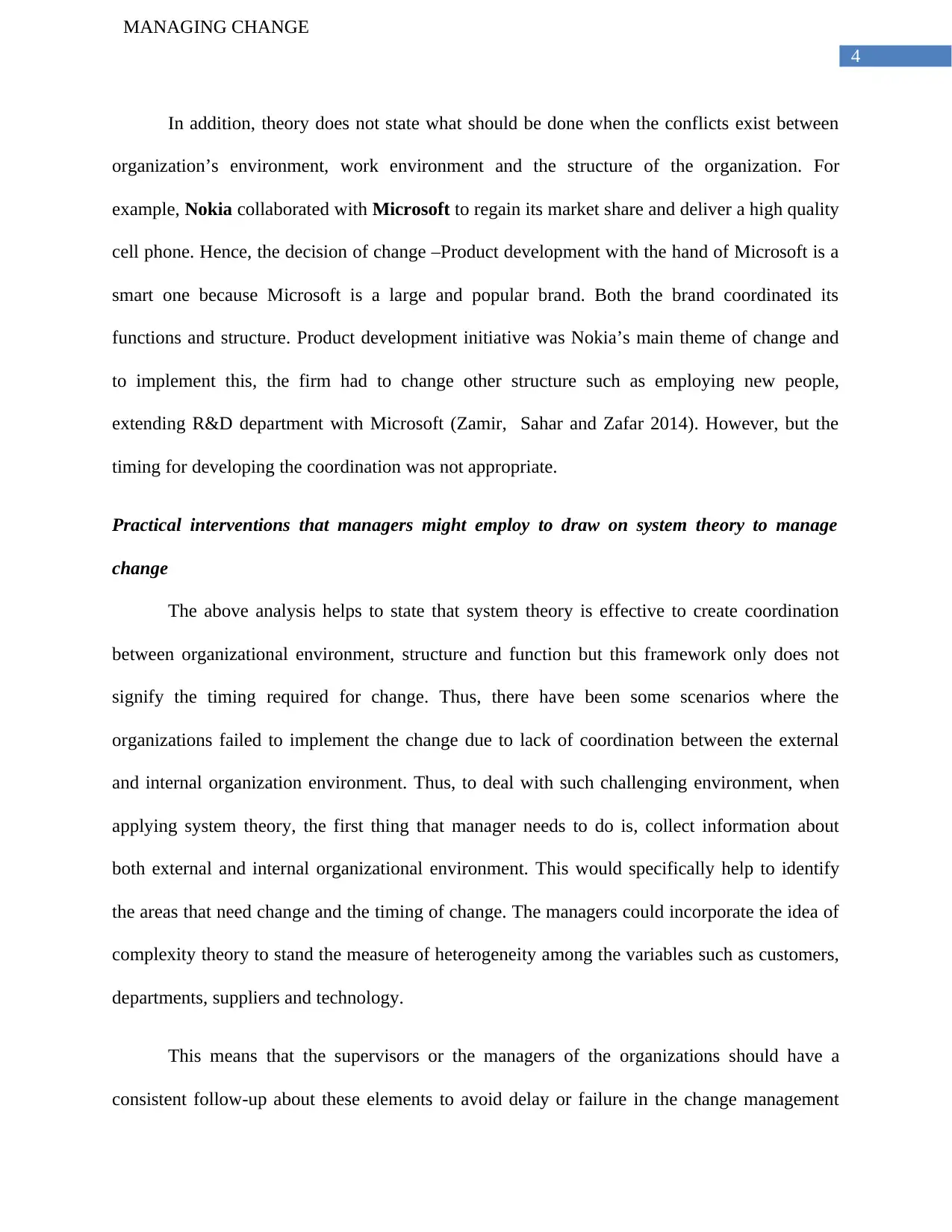
4
MANAGING CHANGE
In addition, theory does not state what should be done when the conflicts exist between
organization’s environment, work environment and the structure of the organization. For
example, Nokia collaborated with Microsoft to regain its market share and deliver a high quality
cell phone. Hence, the decision of change –Product development with the hand of Microsoft is a
smart one because Microsoft is a large and popular brand. Both the brand coordinated its
functions and structure. Product development initiative was Nokia’s main theme of change and
to implement this, the firm had to change other structure such as employing new people,
extending R&D department with Microsoft (Zamir, Sahar and Zafar 2014). However, but the
timing for developing the coordination was not appropriate.
Practical interventions that managers might employ to draw on system theory to manage
change
The above analysis helps to state that system theory is effective to create coordination
between organizational environment, structure and function but this framework only does not
signify the timing required for change. Thus, there have been some scenarios where the
organizations failed to implement the change due to lack of coordination between the external
and internal organization environment. Thus, to deal with such challenging environment, when
applying system theory, the first thing that manager needs to do is, collect information about
both external and internal organizational environment. This would specifically help to identify
the areas that need change and the timing of change. The managers could incorporate the idea of
complexity theory to stand the measure of heterogeneity among the variables such as customers,
departments, suppliers and technology.
This means that the supervisors or the managers of the organizations should have a
consistent follow-up about these elements to avoid delay or failure in the change management
MANAGING CHANGE
In addition, theory does not state what should be done when the conflicts exist between
organization’s environment, work environment and the structure of the organization. For
example, Nokia collaborated with Microsoft to regain its market share and deliver a high quality
cell phone. Hence, the decision of change –Product development with the hand of Microsoft is a
smart one because Microsoft is a large and popular brand. Both the brand coordinated its
functions and structure. Product development initiative was Nokia’s main theme of change and
to implement this, the firm had to change other structure such as employing new people,
extending R&D department with Microsoft (Zamir, Sahar and Zafar 2014). However, but the
timing for developing the coordination was not appropriate.
Practical interventions that managers might employ to draw on system theory to manage
change
The above analysis helps to state that system theory is effective to create coordination
between organizational environment, structure and function but this framework only does not
signify the timing required for change. Thus, there have been some scenarios where the
organizations failed to implement the change due to lack of coordination between the external
and internal organization environment. Thus, to deal with such challenging environment, when
applying system theory, the first thing that manager needs to do is, collect information about
both external and internal organizational environment. This would specifically help to identify
the areas that need change and the timing of change. The managers could incorporate the idea of
complexity theory to stand the measure of heterogeneity among the variables such as customers,
departments, suppliers and technology.
This means that the supervisors or the managers of the organizations should have a
consistent follow-up about these elements to avoid delay or failure in the change management
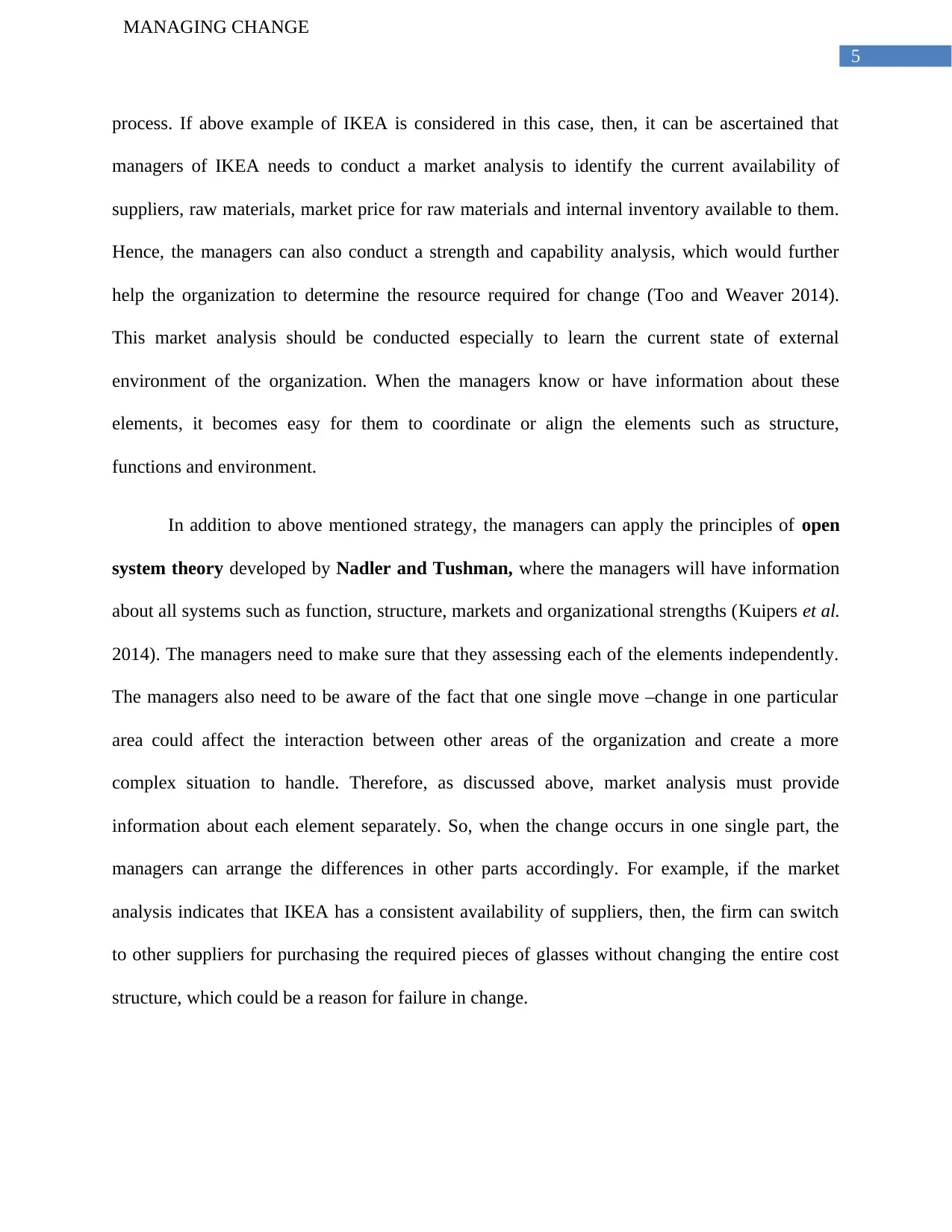
5
MANAGING CHANGE
process. If above example of IKEA is considered in this case, then, it can be ascertained that
managers of IKEA needs to conduct a market analysis to identify the current availability of
suppliers, raw materials, market price for raw materials and internal inventory available to them.
Hence, the managers can also conduct a strength and capability analysis, which would further
help the organization to determine the resource required for change (Too and Weaver 2014).
This market analysis should be conducted especially to learn the current state of external
environment of the organization. When the managers know or have information about these
elements, it becomes easy for them to coordinate or align the elements such as structure,
functions and environment.
In addition to above mentioned strategy, the managers can apply the principles of open
system theory developed by Nadler and Tushman, where the managers will have information
about all systems such as function, structure, markets and organizational strengths (Kuipers et al.
2014). The managers need to make sure that they assessing each of the elements independently.
The managers also need to be aware of the fact that one single move –change in one particular
area could affect the interaction between other areas of the organization and create a more
complex situation to handle. Therefore, as discussed above, market analysis must provide
information about each element separately. So, when the change occurs in one single part, the
managers can arrange the differences in other parts accordingly. For example, if the market
analysis indicates that IKEA has a consistent availability of suppliers, then, the firm can switch
to other suppliers for purchasing the required pieces of glasses without changing the entire cost
structure, which could be a reason for failure in change.
MANAGING CHANGE
process. If above example of IKEA is considered in this case, then, it can be ascertained that
managers of IKEA needs to conduct a market analysis to identify the current availability of
suppliers, raw materials, market price for raw materials and internal inventory available to them.
Hence, the managers can also conduct a strength and capability analysis, which would further
help the organization to determine the resource required for change (Too and Weaver 2014).
This market analysis should be conducted especially to learn the current state of external
environment of the organization. When the managers know or have information about these
elements, it becomes easy for them to coordinate or align the elements such as structure,
functions and environment.
In addition to above mentioned strategy, the managers can apply the principles of open
system theory developed by Nadler and Tushman, where the managers will have information
about all systems such as function, structure, markets and organizational strengths (Kuipers et al.
2014). The managers need to make sure that they assessing each of the elements independently.
The managers also need to be aware of the fact that one single move –change in one particular
area could affect the interaction between other areas of the organization and create a more
complex situation to handle. Therefore, as discussed above, market analysis must provide
information about each element separately. So, when the change occurs in one single part, the
managers can arrange the differences in other parts accordingly. For example, if the market
analysis indicates that IKEA has a consistent availability of suppliers, then, the firm can switch
to other suppliers for purchasing the required pieces of glasses without changing the entire cost
structure, which could be a reason for failure in change.
⊘ This is a preview!⊘
Do you want full access?
Subscribe today to unlock all pages.

Trusted by 1+ million students worldwide
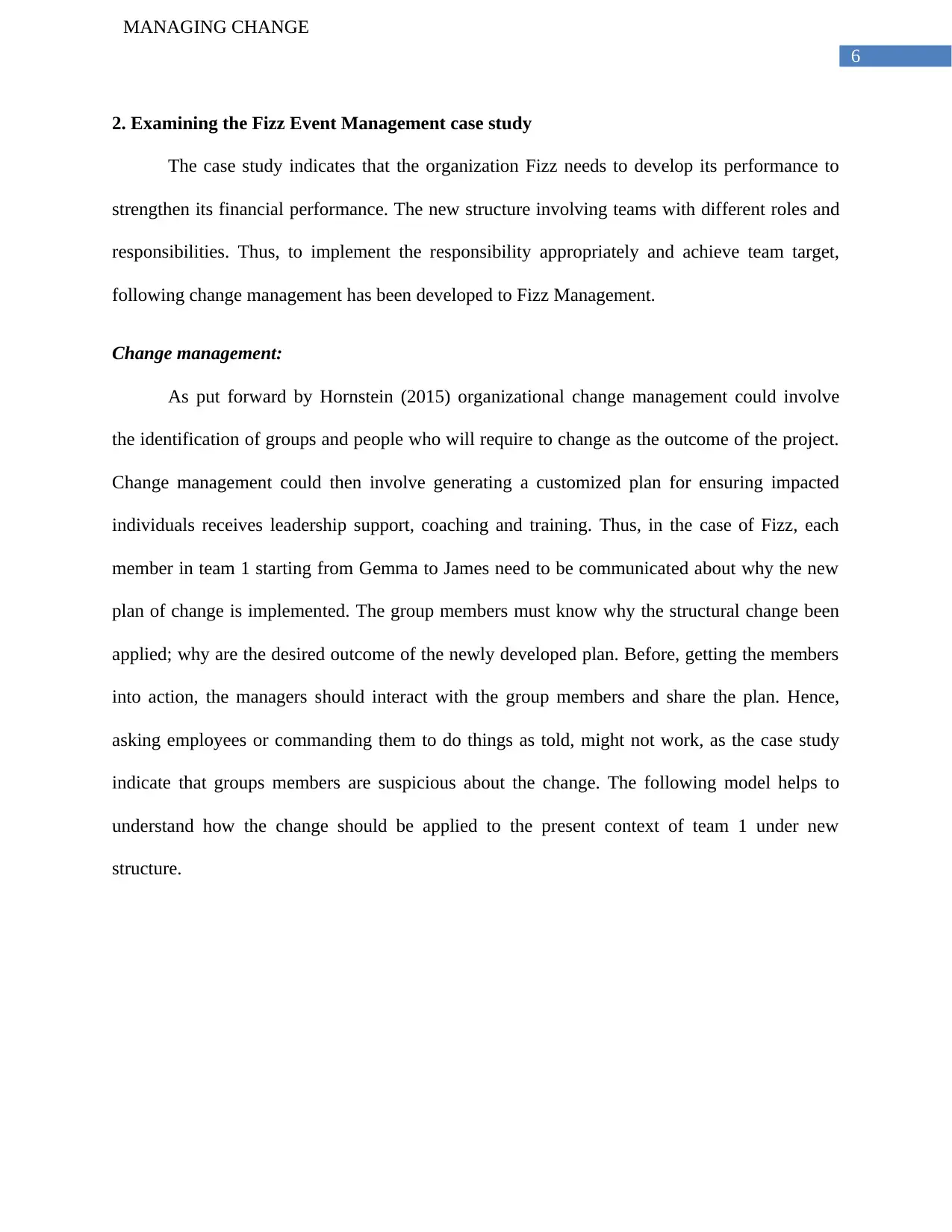
6
MANAGING CHANGE
2. Examining the Fizz Event Management case study
The case study indicates that the organization Fizz needs to develop its performance to
strengthen its financial performance. The new structure involving teams with different roles and
responsibilities. Thus, to implement the responsibility appropriately and achieve team target,
following change management has been developed to Fizz Management.
Change management:
As put forward by Hornstein (2015) organizational change management could involve
the identification of groups and people who will require to change as the outcome of the project.
Change management could then involve generating a customized plan for ensuring impacted
individuals receives leadership support, coaching and training. Thus, in the case of Fizz, each
member in team 1 starting from Gemma to James need to be communicated about why the new
plan of change is implemented. The group members must know why the structural change been
applied; why are the desired outcome of the newly developed plan. Before, getting the members
into action, the managers should interact with the group members and share the plan. Hence,
asking employees or commanding them to do things as told, might not work, as the case study
indicate that groups members are suspicious about the change. The following model helps to
understand how the change should be applied to the present context of team 1 under new
structure.
MANAGING CHANGE
2. Examining the Fizz Event Management case study
The case study indicates that the organization Fizz needs to develop its performance to
strengthen its financial performance. The new structure involving teams with different roles and
responsibilities. Thus, to implement the responsibility appropriately and achieve team target,
following change management has been developed to Fizz Management.
Change management:
As put forward by Hornstein (2015) organizational change management could involve
the identification of groups and people who will require to change as the outcome of the project.
Change management could then involve generating a customized plan for ensuring impacted
individuals receives leadership support, coaching and training. Thus, in the case of Fizz, each
member in team 1 starting from Gemma to James need to be communicated about why the new
plan of change is implemented. The group members must know why the structural change been
applied; why are the desired outcome of the newly developed plan. Before, getting the members
into action, the managers should interact with the group members and share the plan. Hence,
asking employees or commanding them to do things as told, might not work, as the case study
indicate that groups members are suspicious about the change. The following model helps to
understand how the change should be applied to the present context of team 1 under new
structure.
Paraphrase This Document
Need a fresh take? Get an instant paraphrase of this document with our AI Paraphraser
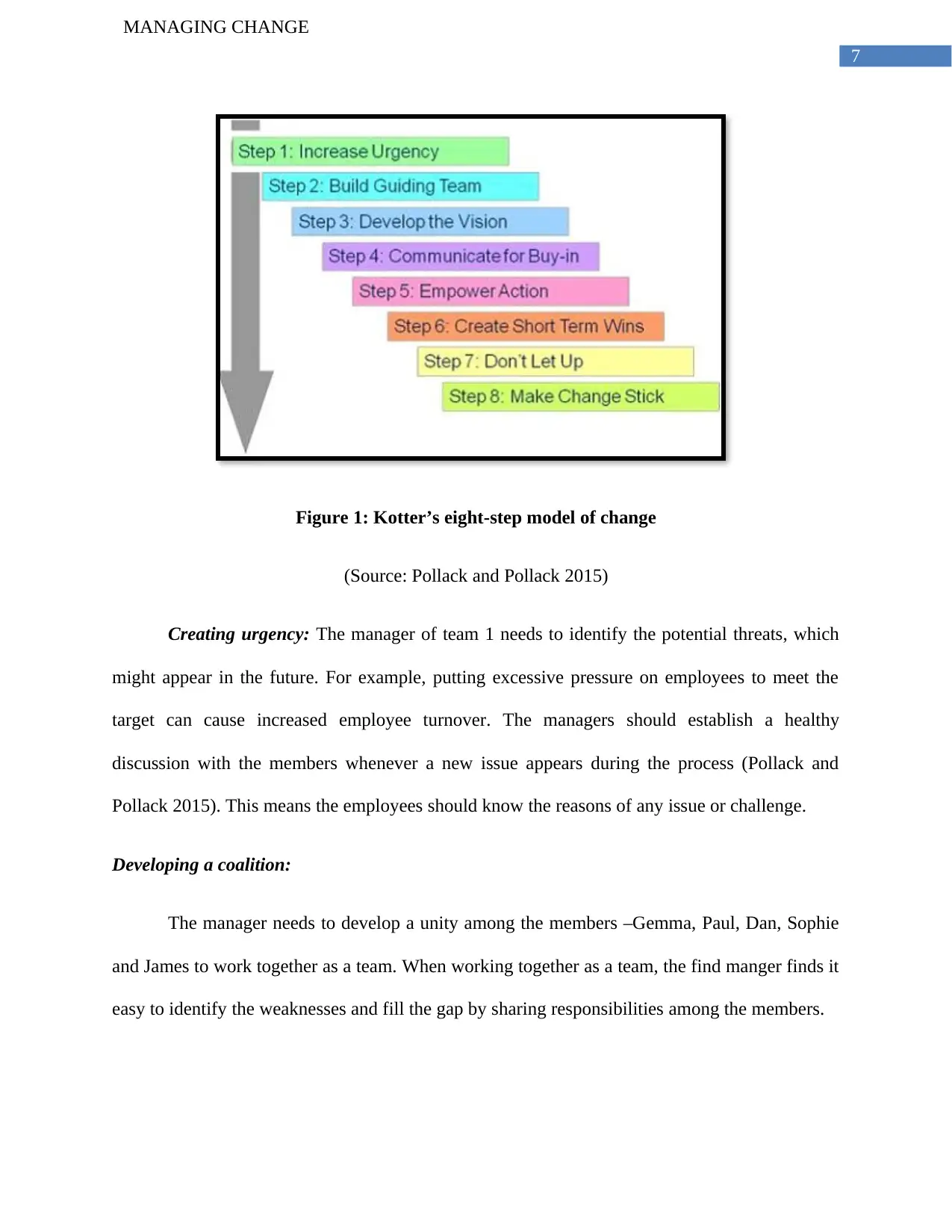
7
MANAGING CHANGE
Figure 1: Kotter’s eight-step model of change
(Source: Pollack and Pollack 2015)
Creating urgency: The manager of team 1 needs to identify the potential threats, which
might appear in the future. For example, putting excessive pressure on employees to meet the
target can cause increased employee turnover. The managers should establish a healthy
discussion with the members whenever a new issue appears during the process (Pollack and
Pollack 2015). This means the employees should know the reasons of any issue or challenge.
Developing a coalition:
The manager needs to develop a unity among the members –Gemma, Paul, Dan, Sophie
and James to work together as a team. When working together as a team, the find manger finds it
easy to identify the weaknesses and fill the gap by sharing responsibilities among the members.
MANAGING CHANGE
Figure 1: Kotter’s eight-step model of change
(Source: Pollack and Pollack 2015)
Creating urgency: The manager of team 1 needs to identify the potential threats, which
might appear in the future. For example, putting excessive pressure on employees to meet the
target can cause increased employee turnover. The managers should establish a healthy
discussion with the members whenever a new issue appears during the process (Pollack and
Pollack 2015). This means the employees should know the reasons of any issue or challenge.
Developing a coalition:
The manager needs to develop a unity among the members –Gemma, Paul, Dan, Sophie
and James to work together as a team. When working together as a team, the find manger finds it
easy to identify the weaknesses and fill the gap by sharing responsibilities among the members.
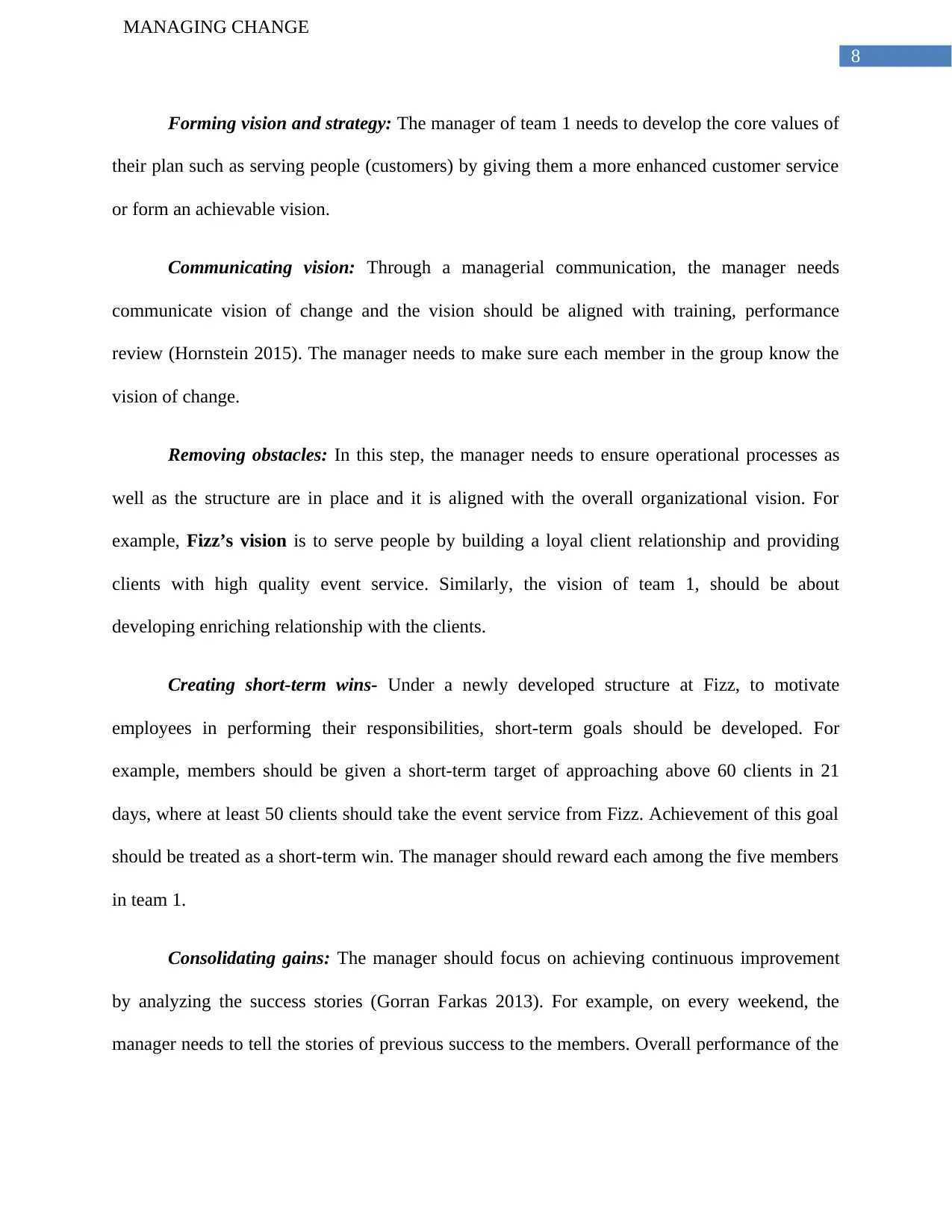
8
MANAGING CHANGE
Forming vision and strategy: The manager of team 1 needs to develop the core values of
their plan such as serving people (customers) by giving them a more enhanced customer service
or form an achievable vision.
Communicating vision: Through a managerial communication, the manager needs
communicate vision of change and the vision should be aligned with training, performance
review (Hornstein 2015). The manager needs to make sure each member in the group know the
vision of change.
Removing obstacles: In this step, the manager needs to ensure operational processes as
well as the structure are in place and it is aligned with the overall organizational vision. For
example, Fizz’s vision is to serve people by building a loyal client relationship and providing
clients with high quality event service. Similarly, the vision of team 1, should be about
developing enriching relationship with the clients.
Creating short-term wins- Under a newly developed structure at Fizz, to motivate
employees in performing their responsibilities, short-term goals should be developed. For
example, members should be given a short-term target of approaching above 60 clients in 21
days, where at least 50 clients should take the event service from Fizz. Achievement of this goal
should be treated as a short-term win. The manager should reward each among the five members
in team 1.
Consolidating gains: The manager should focus on achieving continuous improvement
by analyzing the success stories (Gorran Farkas 2013). For example, on every weekend, the
manager needs to tell the stories of previous success to the members. Overall performance of the
MANAGING CHANGE
Forming vision and strategy: The manager of team 1 needs to develop the core values of
their plan such as serving people (customers) by giving them a more enhanced customer service
or form an achievable vision.
Communicating vision: Through a managerial communication, the manager needs
communicate vision of change and the vision should be aligned with training, performance
review (Hornstein 2015). The manager needs to make sure each member in the group know the
vision of change.
Removing obstacles: In this step, the manager needs to ensure operational processes as
well as the structure are in place and it is aligned with the overall organizational vision. For
example, Fizz’s vision is to serve people by building a loyal client relationship and providing
clients with high quality event service. Similarly, the vision of team 1, should be about
developing enriching relationship with the clients.
Creating short-term wins- Under a newly developed structure at Fizz, to motivate
employees in performing their responsibilities, short-term goals should be developed. For
example, members should be given a short-term target of approaching above 60 clients in 21
days, where at least 50 clients should take the event service from Fizz. Achievement of this goal
should be treated as a short-term win. The manager should reward each among the five members
in team 1.
Consolidating gains: The manager should focus on achieving continuous improvement
by analyzing the success stories (Gorran Farkas 2013). For example, on every weekend, the
manager needs to tell the stories of previous success to the members. Overall performance of the
⊘ This is a preview!⊘
Do you want full access?
Subscribe today to unlock all pages.

Trusted by 1+ million students worldwide
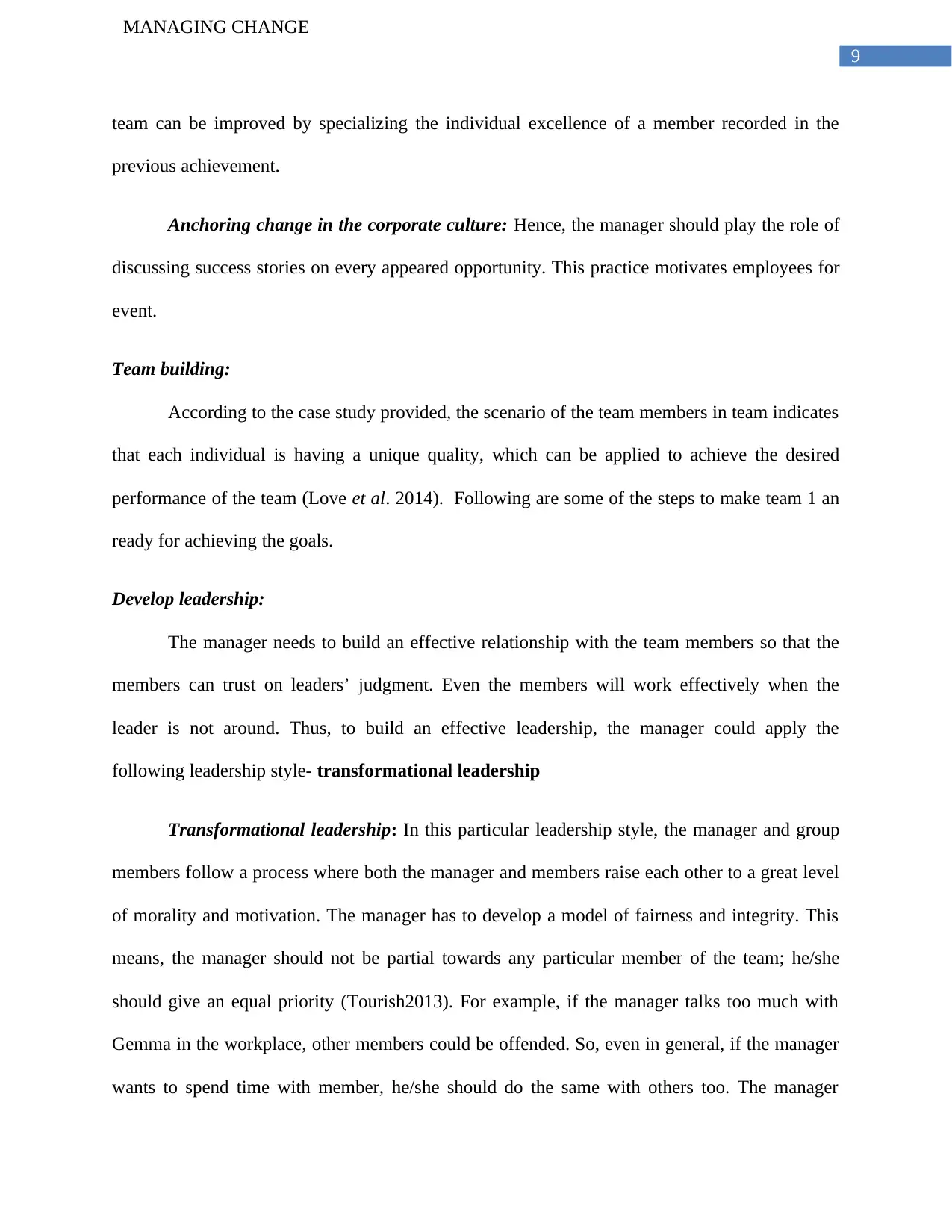
9
MANAGING CHANGE
team can be improved by specializing the individual excellence of a member recorded in the
previous achievement.
Anchoring change in the corporate culture: Hence, the manager should play the role of
discussing success stories on every appeared opportunity. This practice motivates employees for
event.
Team building:
According to the case study provided, the scenario of the team members in team indicates
that each individual is having a unique quality, which can be applied to achieve the desired
performance of the team (Love et al. 2014). Following are some of the steps to make team 1 an
ready for achieving the goals.
Develop leadership:
The manager needs to build an effective relationship with the team members so that the
members can trust on leaders’ judgment. Even the members will work effectively when the
leader is not around. Thus, to build an effective leadership, the manager could apply the
following leadership style- transformational leadership
Transformational leadership: In this particular leadership style, the manager and group
members follow a process where both the manager and members raise each other to a great level
of morality and motivation. The manager has to develop a model of fairness and integrity. This
means, the manager should not be partial towards any particular member of the team; he/she
should give an equal priority (Tourish2013). For example, if the manager talks too much with
Gemma in the workplace, other members could be offended. So, even in general, if the manager
wants to spend time with member, he/she should do the same with others too. The manager
MANAGING CHANGE
team can be improved by specializing the individual excellence of a member recorded in the
previous achievement.
Anchoring change in the corporate culture: Hence, the manager should play the role of
discussing success stories on every appeared opportunity. This practice motivates employees for
event.
Team building:
According to the case study provided, the scenario of the team members in team indicates
that each individual is having a unique quality, which can be applied to achieve the desired
performance of the team (Love et al. 2014). Following are some of the steps to make team 1 an
ready for achieving the goals.
Develop leadership:
The manager needs to build an effective relationship with the team members so that the
members can trust on leaders’ judgment. Even the members will work effectively when the
leader is not around. Thus, to build an effective leadership, the manager could apply the
following leadership style- transformational leadership
Transformational leadership: In this particular leadership style, the manager and group
members follow a process where both the manager and members raise each other to a great level
of morality and motivation. The manager has to develop a model of fairness and integrity. This
means, the manager should not be partial towards any particular member of the team; he/she
should give an equal priority (Tourish2013). For example, if the manager talks too much with
Gemma in the workplace, other members could be offended. So, even in general, if the manager
wants to spend time with member, he/she should do the same with others too. The manager
Paraphrase This Document
Need a fresh take? Get an instant paraphrase of this document with our AI Paraphraser
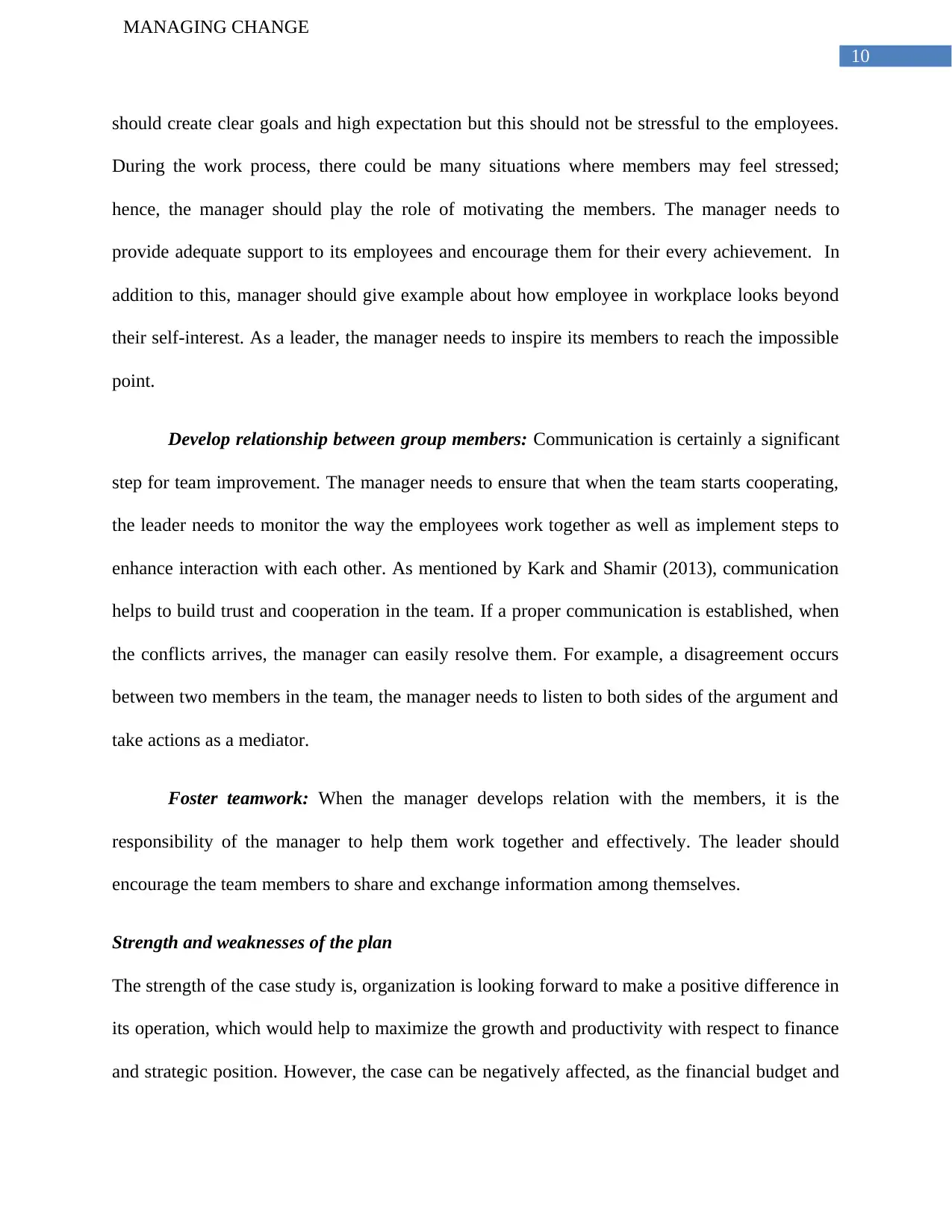
10
MANAGING CHANGE
should create clear goals and high expectation but this should not be stressful to the employees.
During the work process, there could be many situations where members may feel stressed;
hence, the manager should play the role of motivating the members. The manager needs to
provide adequate support to its employees and encourage them for their every achievement. In
addition to this, manager should give example about how employee in workplace looks beyond
their self-interest. As a leader, the manager needs to inspire its members to reach the impossible
point.
Develop relationship between group members: Communication is certainly a significant
step for team improvement. The manager needs to ensure that when the team starts cooperating,
the leader needs to monitor the way the employees work together as well as implement steps to
enhance interaction with each other. As mentioned by Kark and Shamir (2013), communication
helps to build trust and cooperation in the team. If a proper communication is established, when
the conflicts arrives, the manager can easily resolve them. For example, a disagreement occurs
between two members in the team, the manager needs to listen to both sides of the argument and
take actions as a mediator.
Foster teamwork: When the manager develops relation with the members, it is the
responsibility of the manager to help them work together and effectively. The leader should
encourage the team members to share and exchange information among themselves.
Strength and weaknesses of the plan
The strength of the case study is, organization is looking forward to make a positive difference in
its operation, which would help to maximize the growth and productivity with respect to finance
and strategic position. However, the case can be negatively affected, as the financial budget and
MANAGING CHANGE
should create clear goals and high expectation but this should not be stressful to the employees.
During the work process, there could be many situations where members may feel stressed;
hence, the manager should play the role of motivating the members. The manager needs to
provide adequate support to its employees and encourage them for their every achievement. In
addition to this, manager should give example about how employee in workplace looks beyond
their self-interest. As a leader, the manager needs to inspire its members to reach the impossible
point.
Develop relationship between group members: Communication is certainly a significant
step for team improvement. The manager needs to ensure that when the team starts cooperating,
the leader needs to monitor the way the employees work together as well as implement steps to
enhance interaction with each other. As mentioned by Kark and Shamir (2013), communication
helps to build trust and cooperation in the team. If a proper communication is established, when
the conflicts arrives, the manager can easily resolve them. For example, a disagreement occurs
between two members in the team, the manager needs to listen to both sides of the argument and
take actions as a mediator.
Foster teamwork: When the manager develops relation with the members, it is the
responsibility of the manager to help them work together and effectively. The leader should
encourage the team members to share and exchange information among themselves.
Strength and weaknesses of the plan
The strength of the case study is, organization is looking forward to make a positive difference in
its operation, which would help to maximize the growth and productivity with respect to finance
and strategic position. However, the case can be negatively affected, as the financial budget and
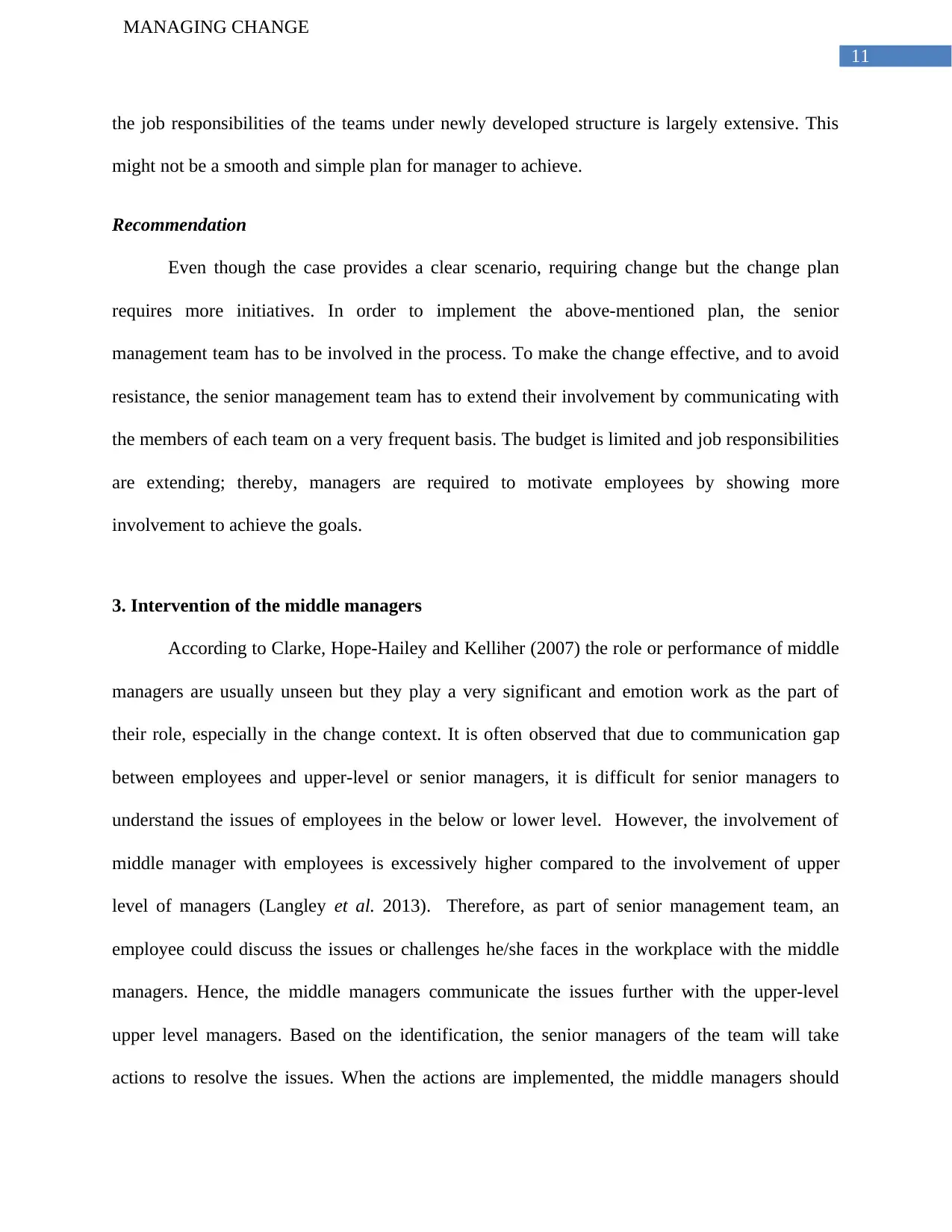
11
MANAGING CHANGE
the job responsibilities of the teams under newly developed structure is largely extensive. This
might not be a smooth and simple plan for manager to achieve.
Recommendation
Even though the case provides a clear scenario, requiring change but the change plan
requires more initiatives. In order to implement the above-mentioned plan, the senior
management team has to be involved in the process. To make the change effective, and to avoid
resistance, the senior management team has to extend their involvement by communicating with
the members of each team on a very frequent basis. The budget is limited and job responsibilities
are extending; thereby, managers are required to motivate employees by showing more
involvement to achieve the goals.
3. Intervention of the middle managers
According to Clarke, Hope-Hailey and Kelliher (2007) the role or performance of middle
managers are usually unseen but they play a very significant and emotion work as the part of
their role, especially in the change context. It is often observed that due to communication gap
between employees and upper-level or senior managers, it is difficult for senior managers to
understand the issues of employees in the below or lower level. However, the involvement of
middle manager with employees is excessively higher compared to the involvement of upper
level of managers (Langley et al. 2013). Therefore, as part of senior management team, an
employee could discuss the issues or challenges he/she faces in the workplace with the middle
managers. Hence, the middle managers communicate the issues further with the upper-level
upper level managers. Based on the identification, the senior managers of the team will take
actions to resolve the issues. When the actions are implemented, the middle managers should
MANAGING CHANGE
the job responsibilities of the teams under newly developed structure is largely extensive. This
might not be a smooth and simple plan for manager to achieve.
Recommendation
Even though the case provides a clear scenario, requiring change but the change plan
requires more initiatives. In order to implement the above-mentioned plan, the senior
management team has to be involved in the process. To make the change effective, and to avoid
resistance, the senior management team has to extend their involvement by communicating with
the members of each team on a very frequent basis. The budget is limited and job responsibilities
are extending; thereby, managers are required to motivate employees by showing more
involvement to achieve the goals.
3. Intervention of the middle managers
According to Clarke, Hope-Hailey and Kelliher (2007) the role or performance of middle
managers are usually unseen but they play a very significant and emotion work as the part of
their role, especially in the change context. It is often observed that due to communication gap
between employees and upper-level or senior managers, it is difficult for senior managers to
understand the issues of employees in the below or lower level. However, the involvement of
middle manager with employees is excessively higher compared to the involvement of upper
level of managers (Langley et al. 2013). Therefore, as part of senior management team, an
employee could discuss the issues or challenges he/she faces in the workplace with the middle
managers. Hence, the middle managers communicate the issues further with the upper-level
upper level managers. Based on the identification, the senior managers of the team will take
actions to resolve the issues. When the actions are implemented, the middle managers should
⊘ This is a preview!⊘
Do you want full access?
Subscribe today to unlock all pages.

Trusted by 1+ million students worldwide
1 out of 18
Related Documents
Your All-in-One AI-Powered Toolkit for Academic Success.
+13062052269
info@desklib.com
Available 24*7 on WhatsApp / Email
![[object Object]](/_next/static/media/star-bottom.7253800d.svg)
Unlock your academic potential
Copyright © 2020–2025 A2Z Services. All Rights Reserved. Developed and managed by ZUCOL.




